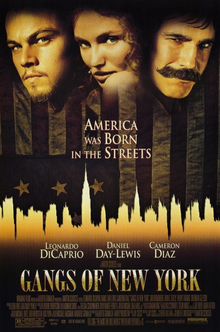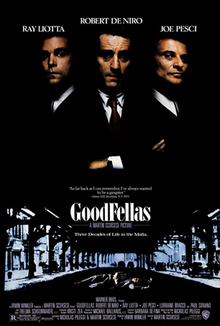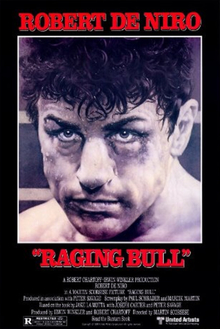







Cast: Nicolas Cage, Patricia Arquette, John Goodman, Ving Rhames, Tom Sizemore, Marc Anthony, Mary Beth Hurt, Cliff Curtis, Nestor Serrano, Aida Turturro, Sonja Sohn. Screenplay: Paul Schrader, based on a novel by Joe Connelly. Cinematography: Robert Richardson. Production design: Dante Ferretti. Film editing: Thelma Schoonmaker. Music: Elmer Bernstein.
A blog formerly known as Bookishness / By Charles Matthews
"Dazzled by so many and such marvelous inventions, the people of Macondo ... became indignant over the living images that the prosperous merchant Bruno Crespi projected in the theater with the lion-head ticket windows, for a character who had died and was buried in one film and for whose misfortune tears had been shed would reappear alive and transformed into an Arab in the next one. The audience, who had paid two cents apiece to share the difficulties of the actors, would not tolerate that outlandish fraud and they broke up the seats. The mayor, at the urging of Bruno Crespi, explained in a proclamation that the cinema was a machine of illusions that did not merit the emotional outbursts of the audience. With that discouraging explanation many ... decided not to return to the movies, considering that they already had too many troubles of their own to weep over the acted-out misfortunes of imaginary beings."--Gabriel García Márquez, One Hundred Years of Solitude
Search This Blog
Saturday, May 25, 2024
Bringing Out the Dead (Martin Scorsese, 1999)
Wednesday, April 24, 2024
After Hours (Martin Scorsese, 1985)
 |
| Griffin Dunne and Teri Garr in After Hours |
Cast: Griffin Dunne, Rosanna Arquette, Verna Bloom, Tommy Chong, Linda Fiorentino, Teri Garr, John Heard, Cheech Marin, Catherine O'Hara, Dick Miller, Will Patton, Robert Plunket, Bronson Pinchot. Screenplay: Joseph Minion. Cinematography: Michael Ballhaus. Production design: Jeffrey Townsend. Film editing: Thelma Schoonmaker. Music: Howard Shore.
Martin Scorsese's dark farce After Hours puts protagonist Paul Hackett (Griffin Dunne) through all the wringers that 1980s New York City could provide. It's often described as "Kafkaesque" with reason: Scorsese borrowed from a Kafka story in the scene in which Paul tries to persuade a doorman to let him into a night club. But it also reflects the director's feelings about being given the runaround by the bureaucracy of the movie business as he tried to get The Last Temptation of Christ (1988) under way. There are those who think After Hours has a misogynistic edge, given that most of Paul's troubles stem from his interactions with women, starting with Marcy (Rosanna Arquette), who flirts with him and sets the whole fantastic plot in motion. But Paul's frantic inability to seize control of events -- some of which, like the loss of his money, are pure accident -- is also to blame. He's an Odysseus blown off course by fate, with the occasional Circe or siren to make things worse.
Monday, January 15, 2024
Killers of the Flower Moon (Martin Scorsese, 2023)
 |
| Leonardo DiCaprio and Lily Gladstone in Killers of the Flower Moon |
Thursday, August 13, 2020
Shutter Island (Martin Scorsese, 2010)
 |
| Ben Kingsley, Mark Ruffalo, and Leonardo DiCaprio in Shutter Island |
Shutter Island is two hours and 18 minutes long, and it feels like it. North by Northwest (Alfred Hitchcock, 1959) is almost as long (two minutes shorter) and it doesn't. Yet Martin Scorsese, who made Shutter Island, is one of the few contemporary directors who are spoken of with much the same reverence as Hitchcock. Granted, comparing the two films is unfair: North by Northwest is meant to be giddy fun, constantly on the move, while Shutter Island is a psychological thriller with horror movie overtones and a claustrophobic setting. So perhaps the more appropriate comparison would be one of Hitchcock's explorations of disordered psychology, Psycho (1960) or Vertigo (1958). The former comes in at 109 minutes, the latter at just a few minutes over two hours. The point here is that Hitchcock knew how to tighten things up. Scorsese may know how, but he doesn't seem to care. He lets Shutter Island slop around, losing tension and focus in the process, when all he really has to do is guide us to a surprise twist and shocking climax. I seem to be one of the few who feel that the film is a tedious indulgence in material of no great matter: Its psychology is unconvincing, its characters are toys, and its payoff is rather pat and formulaic. Still, it gets a whopping 8.2 rating from viewers on IMdB, so I seem to be among the few who feel that too much acting and directing talent has been expended on too little.
Thursday, December 5, 2019
The Irishman (Martin Scorsese, 2019)
The Irishman (Martin Scorsese, 2019)
Cast: Robert De Niro, Al Pacino, Joe Pesci, Harvey Keitel, Ray Romano, Bobby Canavale, Anna Paquin, Stephen Graham, Stephanie Kurtzuba, Jack Huston, Kathrine Narducci, Jesse Plemons, Dominick Lombardozzi, Paul Herman, Gary Basaraba. Screenplay: Steven Zaillian, based on a book by Charles Brandt. Cinematography: Rodrigo Prieto. Production design: Bob Shaw. Film editing: Thelma Schoonmaker. Music: Robbie Robertson.
The Irishman feels valedictory, and not just because it's about gangsters growing old, but also because it's about the kind of gangsters Martin Scorsese and others introduced us to as well as the aging actors who played them: De Niro, Pacino, Pesci, Keitel. And also because it feels like Scorsese's farewell to conventional theatrical release. Movie theaters today thrive on the kind of blockbusters Scorsese has recently dismissed as "not cinema" and more like theme parks. His collaboration with the king of home streaming services, Netflix, seems to announce that a new era of movie distribution and exhibition has arrived -- one in which the old limitations of film content and even length no longer apply. Scorsese recently said that The Irishman's three-and-a-half-hour length would probably hinder its release in today's theaters, where the only movies that long are ones like the three-hour Avengers: Endgame, a "theme park" movie. Exhibitors want films that fit tightly into a schedule, which discourages producers from making epic-length features like Lawrence of Arabia (David Lean, 1962). Netflix audiences, on the other hand, can watch on their own time, with the leisure to interrupt the film at any point for a snack or bathroom break. So a movie like The Irishman, which has an epic length but also a subtle, intimate treatment of its characters, doesn't fit in today's theaters. What's lost, of course, is the communal experience of moviegoing, the sharing by complete strangers of dreams in the dark. But we should be glad that anything makes movies like The Irishman possible. I don't know if it's a "masterpiece," as some enthusiasts have called it, but it's a damn good movie, with the best performances by De Niro and Pacino in years, and a wonderful return from semi-retirement by Pesci, who tamps down his usual ebullience for a quietly sinister but also, in later scenes, touching portrayal of a mob manipulator. The whole thing is a kind of morality tale, with De Niro's Frank Sheeran paying for his many sins by waiting for death in an existential loneliness. It takes a wizard like Scorsese -- helped by Steven Zaillian's screenplay -- to keep that kind of fable from going mawkish and sentimental.
Tuesday, February 13, 2018
Hugo (Martin Scorsese, 2011)
Georges Méliès: Ben Kingsley
Isabelle: Chloë Grace Moretz
Station Inspector: Sacha Baron Cohen
Mama Jeanne: Helen McCrory
Rene Tabard: Michael Stuhlbarg
Uncle Claude: Ray Winstone
Lisette: Emily Mortimer
Monsieur Labisse: Christopher Lee
Madame Emilie: Frances de la Tour
Monsieur Frick: Richard Griffiths
Hugo's Father: Jude Law
Director: Martin Scorsese
Screenplay: John Logan
Based on a novel by Brian Selznick
Cinematography: Robert Richardson
Production design: Dante Ferretti
Film editing: Thelma Schoonmaker
Costume design: Sandy Powell
Music: Howard Shore
Martin Scorsese's fantastical tribute to pioneer filmmaker Georges Méliès begins with a spectacular traveling shot, a combination of CGI and live action, sweeping across Paris and into the Gare Montparnasse until it finishes on a shot of young Hugo Cabret in the clock tower. Normally, I feel that too much CGI robs a movie of its grounding in reality, drawing attention to itself at the expense of characters and story. But on the other hand, who can really doubt that if computer graphics had been available to Georges Méliès, he wouldn't have done something similarly amazing with them, the way he relied on papier-mâché, cardboard, flash powder, and whatever camera tricks he could muster? One of the great delights of Hugo is its re-creations of parts of Méliès's movies, particularly from the behind-the-scenes angle. It's a charming film, perhaps a little overloaded with effects, but Scorsese has a light touch with the story and he has a cast equal to the task of standing up to the computer trickery. A few critics demurred, finding the special effects oppressive, especially in the 3-D version, but on the whole the reviews were raves. It also won Oscars not only for the effects but also for cinematography, art direction, and sound mixing and editing, and was nominated for best picture, director, screenplay, film editing, costumes, and musical score. It seems to me a much better film than the year's best picture winner, The Artist (Michel Haznavicius), coincidentally a movie set in a significant moment in film history. Yet it was a major box-office flop, which may have shadowed its chances at the awards.
Tuesday, December 26, 2017
The Age of Innocence (Martin Scorsese, 1993)
 |
| Daniel Day-Lewis, Winona Ryder, Geraldine Chaplin, and Michelle Pfeiffer in The Age of Innocence |
Ellen Olenska: Michelle Pfeiffer
May Welland: Winona Ryder
Larry Lefferts: Richard E. Grant
Sillerton Jackson: Alec McCowen
Mrs. Welland: Geraldine Chaplin
Regina Beaufort: Mary Beth Hurt
Julius Beaufort: Stuart Wilson
Mrs. Mingott: Miriam Margolyes
Mrs. Archer: Siân Phillips
Henry van der Luyden: Michael Gough
Louisa van der Luyden: Alexis Smith
Mr. Letterblair: Norman Lloyd
Rivière: Jonathan Pryce
Ted Archer: Robert Sean Leonard
Narrator: Joanne Woodward
Director: Martin Scorsese
Screenplay: Jay Cocks, Martin Scorsese
Based on a novel by Edith Wharton
Cinematography: Michael Ballhaus
Production design: Dante Ferretti
Film editing: Thelma Schoonmaker
Costume design: Gabriella Pescucci
Music: Elmer Bernstein
Voiceover narrators in movies are usually to be avoided: They often serve as a crutch for screenwriters and directors who can't tell their stories through dialogue and action. But Joanne Woodward's cool, wry, witty narrator in The Age of Innocence is an essential element: She's really playing Edith Wharton, or more properly the "narrative voice," the storyteller who is there to comment on and clarify the characters and their motives and backstories. It's a device, and a performance, that brings us closer to the source of the movie. Whether that's a good thing or not is subject to debate: Many think that trying to squeeze one medium, literature, together with another, motion pictures, does a disservice to both art forms. Still, The Age of Innocence does it better than most literary movies, including much of the late flood of Jane Austen adaptations and even some of the Merchant Ivory oeuvre. The chief criticism of the film is that it's over-upholstered, that the attention devoted to period detail tends to overwhelm the story. But Martin Scorsese assembled a cast that could upstage all the fabric and cutlery and crockery, starting with Woodward, but of course including the three stars on screen, Daniel Day-Lewis, Michelle Pfeiffer, and Winona Ryder, and extending to one of the best supporting casts ever mustered. My criticism is that the film is overlong, coming in at 139 minutes. I don't begrudge the time spent watching that cast, but the film does Wharton's story a disservice by making it seem more portentous than it is. Epic length in movies is justified if the topic demands it, like the Russian stand against Napoleon in Sergey Bondarchuk's War and Peace (1966) or the struggle to unite Italy in Luchino Visconti's The Leopard (1963), to name two of the more successful historical epics. But Wharton was working, like Austen on her "little bit (two inches wide) of ivory," in comparative miniature, with a thin slice of history in which manners and morals, not countries and continents, were undergoing revolutionary change. Fiction like Wharton's is meditative, film like Scorsese's is visceral, and while narration like Woodward's allows for some of the first, what lives with us after the film ends is likely to be the impact of Dante Ferretti's production design, Gabriella Pescucci's Oscar-winning costumes, Elmer Bernstein's score, and especially Michael Ballhaus's images, not to mention the pleasure of watching Day-Lewis, Pfeiffer, Ryder, et al. at peak performance.
Tuesday, February 28, 2017
Gangs of New York (Martin Scorsese, 2002)
Saturday, June 11, 2016
The Wolf of Wall Street (Martin Scorsese, 2013)
Wednesday, March 23, 2016
The King of Comedy (Martin Scorsese, 1982)
Sunday, February 28, 2016
GoodFellas (Martin Scorsese, 1990)
Wednesday, December 16, 2015
Cape Fear (Martin Scorsese, 1991)
Monday, December 14, 2015
Taxi Driver (Martin Scorsese, 1976)
 |
| Robert De Niro in Taxi Driver |

























